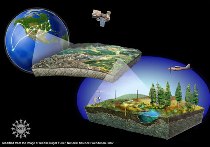Temperature Change in the 21st Century in North America
Author(s): Jonathan Paul Frye
McPherson College
1869 total view(s), 296 download(s)
Summary:
This is an FMN participant modification of the TIEE module "Global Temperature Change in the 21st Century," authored by Daniel R. Taub and Gillian S. Graham in 2011.
Contents:
Bundle(ZIP | 1 MB)
- License terms
Description
The module and supplements were implemented at McPherson College the by Jonathan Frye, PhD.
- Course: BI 310 Statistical Data Analysis
- Course Level: Upper-level natural science majors
- Instructional Setting: Lecture/Lab (Students using computers in the classroom, collaborating synchronously)
- Implementation Timeframe: The course met for two two-hour-long blocks per week. The module occupied 3 class sessions in March and April, with a presentation on Monday May 1st (last week of classes). Some homework (i.e. outside of scheduled class time) was required to complete the data analyses.
Notes
- I distributed the TIEE Climate Change in the 21st Century materials without modification to the students in BI 310 Statistical Data Analysis, including the data sets from 7 different latitudes along the North American transect, from 18°N to 68°N. We discussed, but did not work through the details of the seasonal trend analyses outlined in the exercises.
- The next time that I use this module I will use approximately the same pacing - working through the analysis and presentation of the data over the course of the semester - as well as same objectives for the BI310 Statistical Data Analysis class. Although the TIEE materials provided a context for working on the concepts and skills that were already a part of BI310, I did not provide my students with a separate evaluation rubric for this module as a part of their course. Instead, I shared with them out the outset that I was experimenting with the course, and that my educational experiment would not have any negative consequences for them so long as they participated in good faith. I have found that the goodwill generated by relieving a bit of grade anxiety goes a long way to sustaining the kind of positive and collaborative environment that characterizes the most fruitful of scientific research groups.
- Also, the next time that I use this module we will begin by going to the Canadian Centre for Climate Modeling and Analysis website (http://www.cccma.ec.gc.ca/data/data.shtml) to download and reformat the data sets ourselves. Accessing existing data sets for analysis is an additional skill that this module could help me introduce to my students.
Cite this work
Researchers should cite this work as follows:
- Frye, J. P. (2017). Temperature Change in the 21st Century in North America. ESA Data Discovery FMN (2017), QUBES Educational Resources. doi:10.25334/Q45P49
